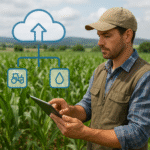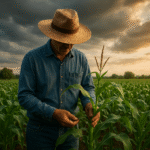The integration of blockchain technology is revolutionizing impressive agriculture by delivering unprecedented levels of transparency and traceability. As global demand for safe and sustainable food escalates, farmers, distributors, retailers, and consumers require reliable data on every step of the journey from seed to plate. Through a combination of distributed ledgers, smart contracts, and networked sensors, stakeholders can record, verify, and share critical information about crop cultivation, harvesting, processing, and transportation. This article explores how blockchain solutions are reshaping modern agriculture, enhancing food security, and fostering consumer trust in the digital age.
Enhancing Traceability from Farm to Table
In traditional supply chains, record-keeping often relies on paper documents or centralized databases that are vulnerable to errors and fraud. Blockchain offers an immutable, tamper-proof decentralization of data, ensuring that all participants view a single source of truth. By timestamping transactions and storing them in cryptographically linked blocks, every action—such as planting, irrigation, fertilization, and harvesting—becomes instantly verifiable.
- Crop Identification: Each harvest batch is assigned a unique digital ID stored on the blockchain, enabling precise tracking of origin and quality.
- Certification Management: Organic and fair-trade certifications can be embedded into the ledger, speeding up audits and validating claims.
- Recall Efficiency: In the event of contamination or safety breaches, affected lots are rapidly pinpointed, minimizing waste and public health risks.
Consumers equipped with smartphone applications can scan QR codes on packaging to access a detailed history of their produce. This deep level of provenance not only empowers buyers but also allows producers to demonstrate compliance with environmental standards and ethical farming practices.
Smart Contracts and Secure Transactions
Automating agreements through smart contracts streamlines commercial relationships among farmers, suppliers, processors, and retailers. These self-executing contracts reside on the blockchain, performing predefined actions once conditions are met. For example, a smart contract might automatically release payment to a grower once a shipment passes a quality control checkpoint recorded on-chain.
Key advantages include:
- Reduced Intermediaries: By eliminating the need for third-party escrow services, transaction costs and delays are significantly lowered.
- Enhanced Accountability: All parties are bound by transparent, immutable code, reducing disputes and fostering trust.
- Instant Settlements: Payments and ownership transfers occur in real time, improving cash flow for smallholders and agribusinesses alike.
Moreover, encryption techniques ensure that sensitive data—such as pricing agreements or yield forecasts—remains confidential, accessible only to authorized participants. This combination of security and automation propels agriculture into the realm of high-efficiency digital commerce.
Integrating IoT Sensors and Data Analytics
The convergence of blockchain with Internet of Things (IoT devices) transforms raw sensor readings into trustworthy data points on an immutable ledger. Soil moisture, ambient temperature, humidity, and pH levels are continuously monitored in the field. When these readings are hashed and recorded on the blockchain, they become auditable proof of environmental conditions throughout the crop lifecycle.
Real-Time Monitoring and Predictive Insights
Advanced analytics platforms leverage on-chain IoT data to forecast yield, detect disease outbreaks, and optimize resource usage. Machine learning models trained on historical records can identify patterns—such as nutrient deficiencies—that human operators might overlook. By integrating this feedback loop, farmers can:
- Adjust irrigation schedules dynamically to conserve water.
- Deploy targeted treatments to reduce pesticide overuse.
- Fine-tune fertilizer application for maximum efficiency.
Ensuring Data Integrity
Without blockchain, sensor networks remain susceptible to tampering, hacking, or accidental falsification. The immutable nature of the distributed ledger guarantees that once a data point is recorded, it cannot be altered. This robust data integrity underpins critical decisions throughout the supply chain, from insurance claims to regulatory compliance.
Overcoming Adoption Barriers and Future Outlook
Despite its potential, blockchain adoption in agriculture faces a range of challenges. Technological constraints, such as network latency and scalability issues, can impede the seamless recording of high-frequency sensor data. Additionally, small-scale farmers may lack the infrastructure and digital literacy needed to participate fully in blockchain networks.
Building Collaborative Ecosystems
Forming consortia of producers, distributors, technology providers, and regulators can accelerate standardization and reduce deployment costs. Shared infrastructure models, where multiple farms access a single blockchain platform, democratize access to cutting-edge tools. Training programs and user-friendly interfaces further lower the barrier to entry, empowering rural communities to harness digital transformation.
Regulatory and Policy Frameworks
Governments and international bodies play a critical role in defining guidelines for data privacy, cross-border transactions, and digital asset recognition. Harmonized policies ensure that blockchain-based records are legally binding and interoperable across jurisdictions. Public-private partnerships can stimulate research, incentivize innovation, and support pilot projects that demonstrate real-world benefits.
Toward a Sustainable Future
Looking ahead, the fusion of blockchain with emerging technologies—such as artificial intelligence, drones, and advanced biotechnologies—promises to elevate agriculture to new heights of productivity and environmental stewardship. By fostering transparent value chains, reducing waste, and enabling equitable compensation, blockchain paves the way for a more resilient and sustainable global food system.
In the dynamic landscape of impressive agriculture, blockchain stands as a transformative force. Its capacity to provide immutable records, automate complex transactions, and integrate with sensor networks equips stakeholders with the tools needed to address pressing challenges in food safety, resource management, and ethical sourcing. As adoption accelerates and ecosystems mature, blockchain-enabled agriculture will continue to redefine what is possible, delivering benefits that resonate from farm fields to dinner tables around the world.










